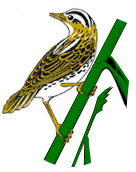

Actualité
31 mars 2017
Recueil d'expériences
Qu'avons nous fait ces six dernières années ? Consultez notre Recueil d'expériences du programme LIFE...
23 janvier 2017
Rapport final 2016
Le rapport final est en ligne avec ses produits livrables et ses annexes !
30 juin 2016
6e Lettre d'information
La sixième lettre d'information est en ligne ! Venez la découvrir !
21 mars 2016
Les mulettes du Sarthon à la loupe !
Des prélèvements ont été réalisés sur certaines mulettes du Sarthon...
07 janvier 2013
Reportage sur Pêche TV
Un reportage sur le LIFE mulette est disponible sur Pêche TV !
- Accueil
- Le phragmite aquatique
- Plan national d'actions
- Les actions du Life ?
- Trois sites expérimentaux
- La communication sur le Life
- La coopération internationale
- Film le séducteur des marais
- Bibliothèque
- Comment participer ?
- L'équipe et les partenariats

English summary of the LIFE program
Conservation of the Aquatic Warbler in Brittany
The Aquatic Warbler Acrocephalus paludicola is one of Europe’s warblers most exposed to the danger of extinction. This explains that it has the status of endangered species on a global scale (SPEC1) and that it is a priority of the Bird Directive of the European Commission. The population of breeders, estimated at about 12 500-20 000 breeding pairs (Aquatic Warbler Conservation Team, 2003), is distributed essentially over Poland and Byelorussia. The wintering zone, which is not clearly known, is situated in western tropical Africa.
Over a period of 25 years information has been collected by ringing stations in the framework of the European programme Acroproject. This information shows that the principal stop-over and fattening-up zone during the post-nuptial migration is situated in the north-west of France along the coast of the Channel and further down along the Atlantic. The zone is characterised by a string of coastal marshes along the Norman and Brittanian coasts, from the Seine Bay to the Loire estuary.
The principal threat on these zones is the absence of management in favour of the Aquatic Warbler. This is enhanced by the secretiveness of this little warbler and the lack of necessary knowledge on behalf of the managers. This absence of management often goes hand in hand with other threats that are always the lot of wetland zones as the degradation of the hydraulic functioning, natural filling-up, water pollution, man-made changes (filling-up, intensive reaping of the reed beds, development for leisure activities or for shooting). These threats all bring with them a loss in diversity of the habitats and a change in their ecological functions for the aquatic warbler i.e. feeding, resting and nocturnal orientation.
Thus the main motivation for this project is to increase the surface of habitats favourable for the migrating Aquatic Warbler along the French coasts of the Atlantic. This general aim can be declined in two specific aims:
|
In Brittany, the project is led on 3 sites designated in SPA, under the responsibility of the proposant, Bretagne Vivante – SEPNB :
The Life is planned over a period of 5 years and 4 months, from Jan 1st 2004 to April 30th 2009. |
© BRETAGNE VIVANTE 2025
-
Mise à jour le 17/05/2023
Réalisé par Cognix Systems sur WebGazelle®








